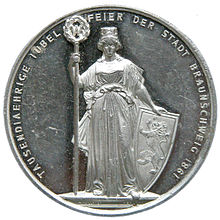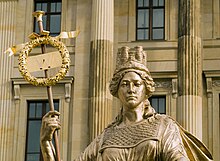Brunonia

Brunonia is that of the brunonids derived symbolic country goddess of the Duchy and Free State of Brunswick , among others represented by Ernst Rietschel as charioteer of the Brunswick Quadriga that on as since October 23, 2008 shopping center serving reconstructing the castle of Braunschweig is in Braunschweig.
It should be understood as the 19th century allegory for the city and country of Braunschweig and thus as a regional analogy to Germania for the German Empire , Helvetia as the embodiment of Switzerland , Britannia for Great Britain and Bavaria for Bavaria .
history
See main article: Braunschweiger Quadriga
First quadriga
The first Brunonia was created as the driver of a four-horse quadriga for the new building of the Braunschweig Castle in the spring of 1863 according to plans by the sculptor Rietschel in the workshop of the ore caster Howaldt in Braunschweig. It was elaborately manufactured from individual copper plates, which were then driven over a steel frame. Just under two years later, however, on February 23 and 24, 1865, it was completely destroyed in a fire in the central part of the castle when the roof collapsed and the entire group of figures fell several floors below. Only her head could be saved, it is now in the City Museum . In 2004 the index finger appeared again. It makes the dimensions of the entire work clear: It weighs 754 g, is 29 cm long and has a diameter of 10.5 cm at the thickest point.
Second quadriga
From 1866 to 1868, Howaldt again created a second version of Brunonia with Quadriga, which was finally placed in its original place on the rebuilt central building in November 1868. It stayed there until the end of the Second World War , although - unlike the surrounding city and the castle that crowned it - it was almost undamaged by the bombing. Only after the end of the war was it almost completely dismantled by non-ferrous metal thieves and thus destroyed. The iron framework was then scrapped when the castle was demolished in 1960.
Third quadriga
Almost 60 years after the end of the war, the city council of Braunschweig decided in 2004 to rebuild or partially reconstruct the Braunschweig palace facade as part of a larger shopping center at its original location. At first it was not intended to produce a new Brunonia with Quadriga, but some private donors and the Richard Borek Foundation decided to finance a third Quadriga. In contrast to its predecessors, this was cast from bronze in a foundry in Posen , as the original manufacturing process of making copper would have been too complex, time-consuming and thus too expensive. The third Brunonia and its four-man team were to be placed on the new building of the Braunschweig Palace in spring 2007. Due to various (technical) delays, however, it took until October 23, 2008 until she and her team of four could be set up again on the central risalit.
The Braunschweiger Quadriga was made according to the original 1: 3 model of the first Rietschel Quadriga, which is now in the Dresden Albertinum . It is - again - the largest quadriga in Germany. The bronze sculpture weighs (including the stainless steel frame) 25.8 tons and measures 9.20 m at its highest point. Brunonia alone is 5.30 m tall. First, the group of figures will shine golden for a few more weeks, until they will finally get the usual patina from the weather and darken until they will finally take on a light green color after about 20 years. Artificial patination was therefore not used.
literature
- Bernd Wedemeyer: Quadriga - The four-horse carriage of the Residenzschloss in Braunschweig , Appelhans Verlag, Braunschweig 2011, ISBN 978-394173765-5
Individual evidence
Web links
Coordinates: 52 ° 15 ′ 48 ″ N , 10 ° 31 ′ 39 ″ E


